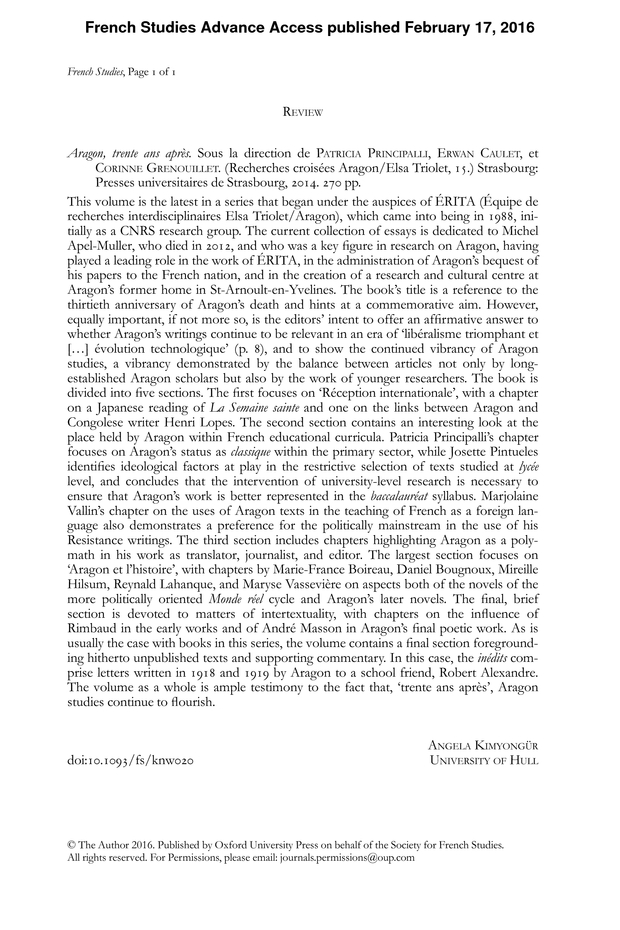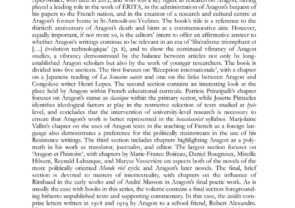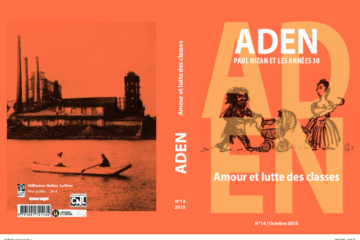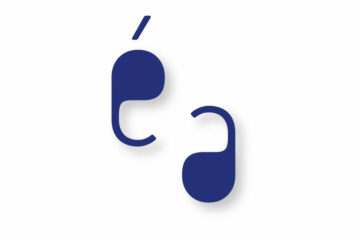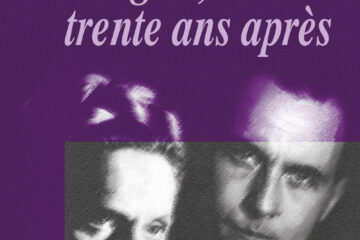Compte rendu d’Aragon, trente ans après par Angela Kimyongür

As its title suggests, this collection of essays is the 15th in a series which began publication in 1988, under the auspices of ERITA (Equipe de recherches interdisciplinaires ElsaTriolet/Aragon) which also came into being in 1988, originally as a CNRS research group. The current volume is dedicated to Michel Apel-Muller who died in 2012, and who is considered to be the founding father of research on Aragon, having played a key role in the work of ERITA, in the administration of Aragon’s bequest of his papers to the French nation and in the creation of a research and cultural centre at Aragon’s former home in St-Arnoux-en-Yvelines. The book’s title is a reference to the 30th anniversary of Aragon’s death and hints at a commemorative aim. However, equally, if not more important, is the editors’ intent to offer an affirmative answer to the question of whether Aragon’s writings continue to be relevant in an era of ‘libéralisme triomphant et (…) évolution technologique’ (p.8) and to show the continued vibrancy of Aragon studies, a vibrancy demonstrated by the balance between articles not only by long established Aragon scholars but by the work of younger researchers. The book is divided up into five sections. The first focuses on ‘Réception internationale’ with a chapter on a Japanese reading of La Semaine sainte and one on the links between Aragon and Congolese writer Henri Lopes. The second section contains an interesting look at the place held by Aragon within French educational curricula. Patricia Principalli’s chapter focuses on Aragon’s status as ‘classique’ within the primary sector, while Josette Pintueles’s contribution identifies ideological factors in play in the selections made of texts studied at lycée level, an impoverishment she concludes requires the intervention of university level research to ensure that his work is better represented in the baccalauréat syllabus. Marjolaine Vallin’s chapter on the uses of Aragon texts in the teaching of French as a foreign language also demonstrates a preference for the politically mainstream in the use of Aragon’s resistance writings. Section three includes chapters highlighting Aragon as a polymath in his work as translator, journalist and editor. The largest section focuses on ‘Aragon et l’histoire’ with chapters by Reynald Lahanque, Mireille Hilsum, Marie-France Boireau, Maryse Vassevière and Daniel Bougnoux on various aspects of both the novels of the more politically oriented Monde réel cycle and of Aragon’s later novels. The final, brief section is devoted to matters of intertextuality with chapters on the influence of Rimbaud in the early works and of André Masson in Aragon’s final poetic work. As is usually the case, the volume contains a final section foregrounding hitherto unpublished texts and supporting commentary. In this case, the ‘inédits’ comprise letters written in 1918 and 1919 by Aragon to a schoolfriend, Robert Alexandre. The volume as a whole is ample testimony to the fact that, ‘trente ans après’, Aragon studies continue to flourish.
Référence : Compte rendu d’Aragon, trente ans après par Angela Kimyongür, French Studies, 17 février 2016
Voir l’article en format photo:
